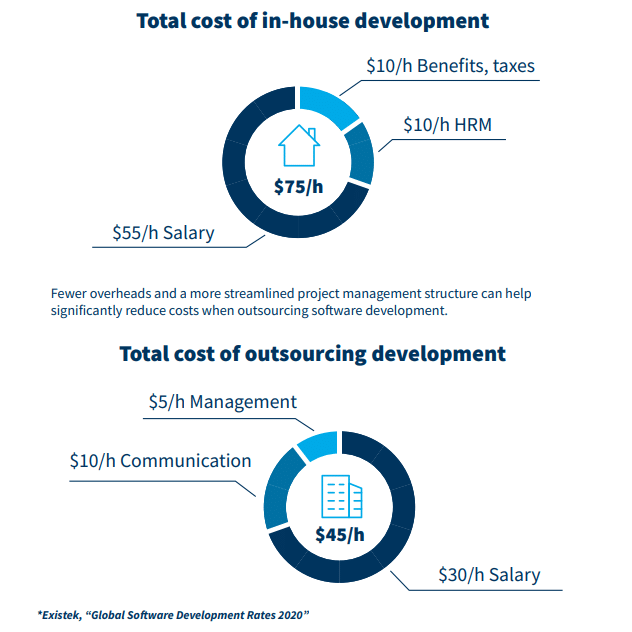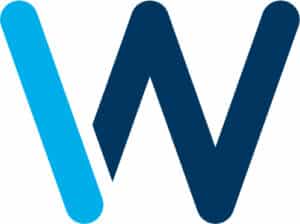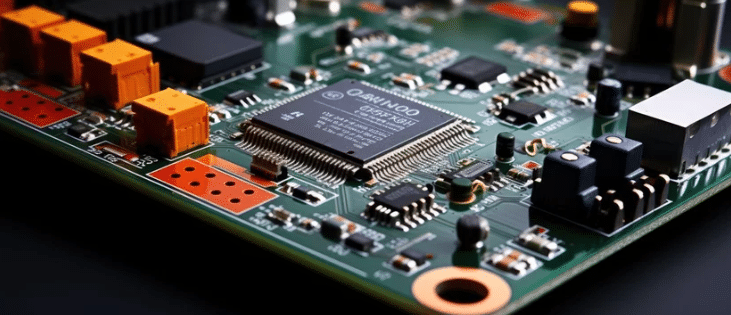Software complexity is accelerating as embedded systems and IoT devices evolve. From AI-driven features to secure cloud connectivity, each leap forward raises the technical bar.
For OEMs, this brings both opportunity and challenge: how to deliver innovative solutions while managing risk, resources, and time-to-market. Recent surveys show that 65% of organizations are implementing IoT strategies, while 41% cite cloud security as their top concern.
The average IoT project break-even point is now 20 months, down from 24 months just five years ago. In this environment, many businesses are asking whether to rely on in-house resources or pursue custom software development outsourcing.

What is Embedded Software Outsourcing and Why Does it Matter?
For embedded and IoT solutions, embedded software outsourcing is not about handing off routine coding tasks. It is a way to access deep expertise that may be difficult or costly to build internally. Embedded systems software development requires close integration between hardware and software, often involving drivers, board support packages, and safety-critical firmware.
This is highly specialized work. Projects in industries like off-highway, healthcare, or industrial machinery demand compliance with strict standards, and even small mistakes can lead to costly delays. Outsourcing embedded software development to experienced partners helps OEMs secure the right skills from day one, accelerating software development timelines and ensuring high-quality code.
There are some considerations companies must think about before moving forward with outsourcing like, intellectual property safeguards, ensure alignment between in-house and outsourced teams, and mitigate potential outsourcing software development risks such as integration setbacks or communication gaps.
Challenges of In-House vs Outsourcing Software Development
Developing embedded solutions in-house provides cultural alignment, direct control, and long-term product familiarity. However, these advantages can be outweighed by serious constraints. The competition for skilled embedded engineers is fierce, and many companies struggle to recruit and retain the talent needed for increasingly complex software projects.
Beyond hiring, costs continue to rise through training, turnover, and management overhead. This makes the “true cost” of in-house software development teams far higher than just salaries. Consider these realities:
- 75% of IoT projects fail to meet their goals.
- 34% of companies struggle with integration.
- 1.4 million full-time developers are missing from the workforce (IDC, 2021)
In-house development teams remain valuable, especially for maintaining software IP and strategic control, but overreliance can slow innovation. In competitive industries where speed-to-market matters, delays can mean lost opportunities, which is why many companies complement their staff with outsourced software development services.
Comparing the Costs of Custom Software Development Outsourcing
Cost is often the first consideration when evaluating outsourced software development services. On average, outsourcing costs about $75 per hour, while in-house development averages closer to $90 per hour once salaries, management, and overhead are included.
The hourly difference may not seem dramatic, but over the course of a project, the impact is significant. A 2,000-hour embedded software project, for example, could cost $30,000 less if outsourced. This does not even factor in hidden costs of in-house development such as recruiting delays, onboarding, training, and turnover.
At the same time, outsourcing software development is not automatically cheaper. Some projects with heavy customization or high compliance needs may carry additional partner fees. What makes outsourcing attractive, however, is not only the potential software outsourcing cost savings but also the flexibility it provides. OEMs can scale resources up or down as needed, access skills that may be hard to recruit internally, and shorten timelines by drawing on software engineering teams with established processes.
By contrast, in-house development offers cultural alignment and long-term product familiarity but comes with higher fixed costs and slower adaptability. This is why many companies evaluate not just the headline hourly rate but the total cost of engagement, weighing financial savings against speed, expertise, and risk.

How to Calculate Software Outsourcing ROI
While hourly rates provide one metric, the more valuable measure is software outsourcing ROI. Calculating ROI requires factoring in both direct and indirect costs:
- In-house: salaries, training, benefits, management overhead.
- Outsourcing: partner fees, consulting, licensing.
- Benefits: faster time-to-market, access to niche skills, reduced project delays.
Consider an OEM that accelerates launch by six months through outsourcing firmware development. The revenue gained from hitting the market earlier may far exceed the cost of outsourcing, delivering a higher ROI than in-house development. This demonstrates why ROI is about more than cost savings, it is about maximizing competitiveness and long-term value.

Why a Hybrid Software Development Model Is Gaining Traction
In-house development and full outsourcing both have their advantages, but each also comes with significant limitations. In-house development teams can maintain control and cultural alignment, yet they often face resource shortages and longer delivery timelines. Full outsourcing provides scalability and access to specialized skills, but it can reduce visibility and increase dependency on external teams.
From our perspective, the most effective way forward is a hybrid software development model. This approach allows in-house engineers to focus on areas where their knowledge is most valuable, such as product strategy or system architecture, while outsourcing partners provide the additional expertise and scalability that accelerate delivery. In our experience, this balance reduces outsourcing software development risks while giving OEMs the flexibility to adapt as projects evolve.
Hybrid models are also well suited to long-term development needs like embedded software lifecycle management. Internal teams can steer the strategic roadmap, while external experts handle maintenance, updates, and compliance requirements over time. This ensures products remain secure, reliable, and competitive long after their initial release.
At Witekio, we are convinced that hybrid is the most resilient model. It combines ownership and control with the speed, adaptability, and breadth of expertise needed to succeed in today’s complex embedded and IoT projects.

Making the Right Choice for Custom Software Development Outsourcing
Custom software development outsourcing is no longer just about reducing costs. It has become a strategic tool for balancing speed, expertise, and long-term sustainability. The choice between in-house vs outsourcing software development is complex, but hybrid approaches often deliver the strongest ROI.
For OEMs seeking to deliver secure, scalable, and future-proof embedded systems, the key lies in choosing partners who can provide not only immediate software development capacity but also long-term lifecycle support.
Download our In-House vs Outsourcing Software Development guide for deeper comparisons, ROI frameworks, and best practices. Or explore Witekio’s embedded software development services to see how our experts support embedded and IoT projects worldwide.
FAQ:
What are the main outsourcing software development services risks?
How much does embedded software outsourcing cost?
What is the software outsourcing ROI compared to in-house development?
What industries benefit most from embedded systems software development outsourcing?
What’s the difference between offshore software development vs nearshoring?
Nearshoring, on the other hand, refers to outsourcing to geographically closer countries, which typically costs more but improves collaboration, reduces cultural barriers, and speeds up certification processes.



